Spot News Roundup
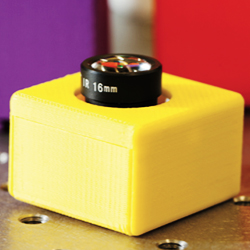
Cameras for All Seasons
Computer Science Professor Shree Nayar and Makoto Odamaki, a visiting scientist from Ricoh Corporation, have developed Cambits, a modular imaging system that enables users to create a wide range of computational cameras. Composed of a set of five different colored blocks including sensors, light sources, actuators, lenses, and optical attachments, Cambits can readily be assembled to make cameras with functionalities including high dynamic range imaging, panoramic imaging, refocusing, light field imaging, depth imaging using stereo, kaleidoscopic imaging, and even microscopy.
The 3D-printed Cambit blocks are quick and easy to configure and operate when plugged into a host computer, tablet, or smartphone. When a set of blocks is put together, the host device is able to power the camera, recognize the setup, and pull up a menu of options, thanks to novel circuit architecture enabling full configurability.
The proof-of-concept project was developed over two years of intensive collaboration and utilizes a suite of computational photography algorithms implemented by a team of MS project students at Columbia Engineering. Nayar and Odamaki hope to partner with a manufacturer to bring their concept to the public.
“We wanted to redefine what we mean by a camera,” says Nayar, the T. C. Chang Professor of Computer Science at Columbia Engineering and a pioneer in the field of computational imaging. “Traditional cameras are really like black boxes that take one type of image. We wanted to rethink the instrument, to come up with a hardware and software system that is modular, reconfigurable, and able to capture all kinds of images. We see Cambits as a wonderful way to unleash the creativity in all of us.”
Materials of Tomorrow
Simon J. L. Billinge, professor of materials science and applied physics, recently received a major grant from the National Science Foundation to help advance his innovative approach to cut the cost of designing custom materials for high-performance devices such as photovoltaics and batteries. The three-year, $983,000 grant, part of a high-profile initiative to fast-track the discovery of new materials, supports research at Columbia University and the National Synchrotron Light Source II at Brookhaven National Lab in Long Island where samples are bombarded with high-energy X-ray beams to probe their nanostructure.
Experiments, with implications for pharmaceutical materials, batteries, catalysts, and novel high-temperature superconductors, explore how the precise atomic structural arrangement of substances affects their behavior. The effort depends on building large databases compiling measured and calculated quantities describing the material structure and properties that will be made available to the larger materials research community. The interdisciplinary project brings together a variety of SEAS faculty, including applied mathematician Qiang Du and computer scientist Daniel Hsu, with expertise in information theory, machine learning, and image recognition.
The goal is to use data analytic techniques, similar to those that power Google and Netflix apps, in combination with latest generation experimental techniques, to accelerate the discovery of novel high-performance materials. Initial targets will be cadmium selenide nanomaterials for photovoltaics and flat-panel displays, and lead telluride, useful as a material for waste heat recovery. Billinge, a member of Columbia’s Data Science Institute, is also investigating how to measure the active ingredients in complex cutting-edge drugs to help make standardized pills that are easily absorbed into the bloodstream.
The Nanostructure Problem: Simon Billinge at Brookhaven National Labs
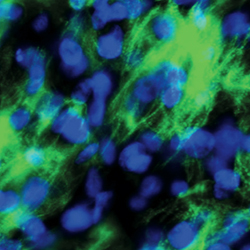
Beat It
Columbia Engineering researchers, led by Professor Gordana Vunjak-Novakovic, have shown, for the first time, that electrical stimulation of human heart muscle cells (cardiomyocytes) engineered from human stem cells aids their development and function. The team used electrical signals, designed to mimic those in a developing heart, to regulate and synchronize the beating properties of nascent cardiomyocytes, the cells that support the beating function of the heart.
“We’ve made an exciting discovery,” says Vunjak-Novakovic, the Mikati Foundation Professor of Biomedical Engineering and a professor of medical sciences. “We applied electrical stimulation to mature these cells, regulate their contractile function, and improve their ability to connect with each other. In fact, we trained the cells to adopt the beating pattern of the heart, improved the organization of important cardiac proteins, and helped the cells to become more adult-like. This preconditioning is an important step to generating robust cells that are useful for a wide range of applications including the study of cardiomyocyte biology, drug testing, and stem cell therapy. And we think that our method could lead to the reduction of arrhythmia during cell-based heart regeneration.”
Vunjak-Novakovic worked with George Eng and Benjamin Lee, both of whom recently received their PhDs from the Department of Biomedical Engineering and were the coleading authors of the study published in Nature Communications in January. The team is currently investigating how the immature heart cells develop their beating function and how to promote integration of engineered cells with the heart muscle.
Embedding Security
To the dismay of malware makers hoping to exploit the emerging Internet of Things, HP announced last fall that it would deploy groundbreaking host-based defense technology developed by Computer Science Professor Sal Stolfo and his former student Ang Cui PhD’15.
The Symbiote defense, which originated at Stolfo’s lab at the Engineering School and was brought to market by their company, Red Balloon Security, via Columbia Technology Ventures, is featured on four new models of multifunction printers as reducing the threat of embedded device malware attacks on end users and organizations. HP will also deliver a firmware update enabling Symbiote on additional printers going as far back as 2011.
The technology, broadly compatible with printers, routers, cars, phones, medical equipment, and more, is the first intrusion defense to provide persistent implant detection, in-device memory monitoring, and situational awareness to protect against malicious attacks. Installing easily on any device without modifying the hardware or source code, Symbiote works with any operating system to embed intrusion detection functionality directly into binary firmware.
With the backing of the federal Department of Defense and Department of Homeland Security, Symbiote was in the works for over five years of development and prototyping. HP is the first company to deploy the advanced anti-malware technology, and Stolfo and Cui next plan to license it to other major vendors of embedded devices.
Hydrate Our Troops
Beating out fierce competition from 16 other schools, a team of recent Columbia Engineering graduates won first place for market-ready bioinstrumentation at the Biomedical Engineering Society’s inaugural Undergraduate Design Competition. Daniel Huang BS’15, Jason Suh BS’15, Shawn Thomas BS’15, and Jennifer Xiong BS’15 presented the Hydrassistant, an advanced dehydration sensor tailored for military use, which began as their senior design project advised by Professor Barclay Morrison III and has continued to evolve postgraduation.
The U.S. military alone reports over 1,500 cases of heat illness each year attributable to dehydration. Hydrassistant is a portable and noninvasive device that uses conductivity sensors to analyze saliva as a biomarker in dehydration diagnosis, particularly amid the physical stress and extreme heat of military field operations. It is integrated with military-grade CamelBak gear for easy deployment on the battlefield. The team competed against five other finalists in oral presentations at the Society’s 25th annual convention last October in Tampa, demonstrating their product’s relevance to compelling clinical needs, market and regulatory viability, business plan, and novelty, among other criteria.
Mentored by Aaron Kyle, senior lecturer in Biomedical Engineering Design, the Hydrassistant team continues development on their novel diagnostic techniques to assess dehydration for personnel operating in field settings.

Brace Yourself
Conventional treatment is constricting and uncomfortable for the approximately one in 500 adolescents who need to wear rigid plastic braces around their hips and torsos to help correct idiopathic scoliosis, a disfiguring and potentially dangerous sideways curvature of the spine. But advances from roboticist Sunil Agrawal, professor of mechanical engineering, include creating dynamic spine braces that could soon allow patients a full range of motion in their everyday lives.
Agrawal and collaborators David P. Roye of Columbia University Medical Center (CUMC) and Charles Kim of Bucknell University received a $1 million grant from the National Science Foundation’s National Robotics Initiative to support their work on revolutionary flexible braces that modulate corrective forces on the spine in desired directions as patients move, grow, and progress throughout the course of treatment.
Prototypes consist of adjustable rings that fit around the human torso. One model has compliant components able to adjust stiffness in specific directions without a power source, while, in a more high-tech version, the rings are dynamically actuated by servomotors to control the force and position applied to the body as sensors transmit data to an onboard computer for monitoring and fine adjustments. The team is currently developing a third hybrid prototype for long-term, low-power use, and planning clinical tests with young scoliosis patients at CUMC.
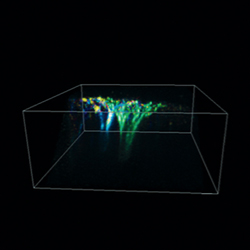
The Future of Microscopy
For her groundbreaking work providing high-resolution, real-time, 3D imaging of the living brain, Professor Elizabeth Hillman has won a major grant from the National Institutes of Health as part of the White House’s Brain Research through Advancing Innovative Neurotechnologies (BRAIN) initiative.
The three-year, $1.83 million award, the first for Columbia Engineering, will help fund development of Hillman’s SCAPE microscope (swept, confocally aligned planar excitation microscopy), which far surpasses most other technologies in terms of 3D imaging speed. SCAPE allows easy observation of neurons communicating with each other in large volumes of neural tissue, and of some small creatures’ entire nervous systems. As a cheaper and simpler alternative to prior methods, it may soon be poised for widespread use across the life sciences.
Hillman, associate professor of biomedical engineering and of radiology, is head of the Laboratory for Functional Optical Imaging, a principal investigator at Columbia’s Mortimer B. Zuckerman Mind Brain Behavior Institute, and a member of the Kavli Institute for Brain Science. She formally debuted SCAPE in Nature Photonics last February, and was quickly inundated with international requests for systems and collaborations. She’s been working on commercializing the technology, available for licensing from Columbia Technology Ventures. In November, she was elected a fellow of the Optical Society of America for her “pioneering contributions to biomedical optical imaging, spectroscopy, and microscopy.”
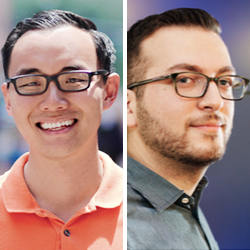
30 Under 30 Game Changers
This year’s Forbes 30 Under 30 list featured several young Columbia engineers making waves in and beyond their professions.
Jason Kang ’16SEAS was recognized in the Healthcare category for Highlight, a powdered additive for disinfectant solutions that help treat surfaces. Developed with Katherine Jin ’16CC and Kevin Tyan ’16CC, the patent-pending product temporarily colorizes decontaminated surfaces while enhancing adhesion and antiviral potency, protecting health personnel potentially exposed to diseases like Ebola.
The trio founded their company, Kinnos, after participating in the School’s Ebola Design Challenge in fall 2014, soon persuading the New York City Fire Department to add Highlight to its HazMat unit’s decontamination protocol. Subsequently, Kinnos won the USAID Fighting Ebola Grand Challenge, earning support for further testing, manufacturing, and deployment.
Forbes also honors the work of Adam Elmachtoub (in the Science category), assistant professor of industrial engineering and operations research and a faculty member of the Data Science Institute; and Michael Wang (Manufacturing & Industry), an adjunct assistant professor of electrical engineering. Elmachtoub explores how businesses can use data science to work more efficiently, while Wang, cofounder of the startup FutureAir, innovates connected air conditioners and fans to reduce carbon emissions.
Additionally, the list features two SEAS alumni: venture capitalist Rami Rahal MS’09 (Venture Capital), cofounder and general partner at Blue Cloud Ventures; and Chelsey Roebuck BS’10 (Education), cofounder of Emerging Leaders in Technology and Engineering (ELiTE). Blue Cloud is a growth-stage firm focused on software-as-a-service companies, while ELiTE helps promote diversity in STEM fields.
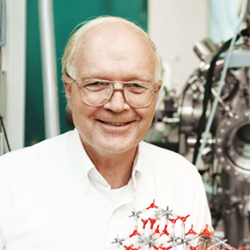
A Life in Lasers
In honor of his contributions to integrated optical devices, Richard M. Osgood, Eugene Higgins Professor Emeritus of Electrical Engineering and professor emeritus of applied physics, has been named a fellow of the National Academy of Inventors (NAI).
Osgood’s specialties include new classes of lasers; the dynamics of lasers’ material medium; the physics, chemistry, and applications of laser surface interactions; computational electromagnetics; and integrated optical devices in silicon and other optical materials. He has 480 journal publications and has received 23 patents, while his lab has been involved in many startups focused on optical materials and materials processing and on optical design software.
A member of the Columbia Engineering faculty since 1981, he cofounded the Columbia Microelectronics Sciences Laboratories (MSL), codirected the Columbia Radiation Laboratory (CRL), and headed up the Columbia University Center for Integrated Science and Engineering (CISE), now the Columbia Nano Initiative. He took a three-year leave of absence to serve as associate laboratory director for basic energy sciences at Brookhaven National Laboratory, where he oversaw the National Synchrotron Light Source, the Center for Functional Nanomaterials, and the Chemistry, Physics, and Materials Science Departments.
Osgood is also a fellow of the American Physical Society (APS), the Institute of Electrical and Electronics Engineers (IEEE), and the Optical Society of America (OSA). Last year, he received the 2015 IEEE Photonics Society Quantum Electronics Award; he is also a recipient of the OSA’s R. W. Wood Award for his research in laser surface chemistry for electronic materials processing and of a Guggenheim fellowship.

Ready...Set...Repair
Biomedical Engineering Professor Helen H. Lu recently won a three-year Translational Research Award grant totaling $1.125 million from the Department of Defense (DoD) for research on tendon-to-bone integration for rotator cuff repair. The funding, part of the DoD’s Orthopaedic Research Program, will support preclinical trials testing a nanofiber-based device to help encourage biological healing between tendon and bone after surgery on the rotator cuff, a commonly injured set of tendons and muscles helping connect the shoulder and upper arm.
Lu has collaborated for a decade with William Levine, chair and professor of orthopedic surgery at Columbia University Medical Center, and researchers including lecturer Katherine E. Reuther, to resolve a major problem with tendon repair. Conventional repair simply reconnects the torn tendon to the upper arm without promoting its integration with bone, leading to a high re-tear rate after surgery. Their innovative approach regenerates the tendon-to-bone interface with a biomimetic nanofiber scaffold coupled with controlled stem cell differentiation, in which parallel nanofibers help foster integrative repair of rotator cuff tears in rebuilding tendon-to-bone connections layer by layer.
The nanofiber-based approach may soon herald a new generation of soft tissue fixation devices for use in sports medicine and treating degenerative joint diseases. Further in the future, Lu anticipates the formation of composite tissue systems and, someday, total joint or limb regeneration.
